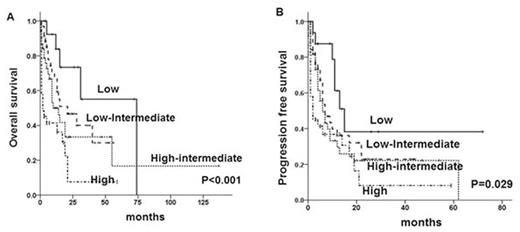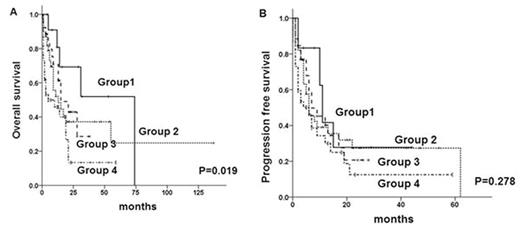Abstract
Abstract
Peripheral T-cell lymphoma (PTCL) is the highly aggressive lymphoid malignancies, treatment outcome is very poor. There are increasing evidence about the role of Epstein-Barr virus (EBV) in PTCL. Because of its rarity, there was few studies about the prognostic factors incorporating EBV in PTCL.
The aim of this study was to evaluate the role of EBV as prognostic factors in PTCL. We retrospectively reviewed the 174 PTCL patients (peripheral T-cell lymphoma, not otherwise specified; n=123, anaplastic large cell lymphoma; n=19, angioimmunoblastic T-cell lymphoma; n=26, enteropathy related T-cell lymphoma, n=5, hepatosplenic gammadelta T-cell lymphoma; n=1).
Median age of the patients was 63 (20~94) years with 107 (61.5%) male patients. One-year OS and PFS was 55.5%, 37.5%, respectively. Stage 3 or 4 patients were 150 (86.2%). Bone marrow involvement were detected 73 (42.0%) patients among 163 available patients. For IPI scores, 29 (16.7%) patients were classified as low risk, 42 (24.1%) as low-intermediate risk, 57 (32.8%) as high-intermediate risk, and 46 (26.4%) as high risk. For PIT scores, 18 (11.1%) patients were classified in group 1, 41 (25.2%) in group 2, 58 (35.6%) in group 3, and 46 (28.2%) in group 4.
Upfront autologous hematopoietic stem cell transplantation (n=17) improved OS and PFS (P=0.001 and P<0.001, respectively). In univariate analysis, poor performance status (ECOG ¡Ã2) (P <0.001 and P <0.001, respectively), low absolute lymphocyte counts (<1000/mm3) (P=0.022 and P=0.038, respectively), high ferritin (¡Ã1,000/mm3) (P =0.002 and P =0.002, respectively), EBV viremia in the whole blood (positive) (P=0.016 and P <0.001, respectively), low protein level (<6.3 g/dL) (P <0.001 and P <0.001, respectively) and low albumin level (<3.5 g/dL) (P =0.001 and P =0.001, respectively) were related with inferior OS and PFS. High international prognostic index (IPI) and prognostic index for PTCLu (PIT) were related with inferior OS and PFS (P<0.001, P=0.029 and P=0.019, P=0.278, respectively) (Figure 1A, 1B, 2A, 2B). In multivariate analysis, poor performance status, extranodal involvement more than one site and EBV viremia were related with OS and PFS in multivariate analysis. (P <0.001, P =0.024, P =0.001 and P =0.001, P=0.002, P=0.031, respectively).
We made a new prognostic score model using statistically significant 3 variables in multivariate analysis: low, no adverse factors; intermediate, one factor; high, two or three factors. This model could identify three groups of patients for OS and PFS (Figure 3A,3B.)
This study suggests that prognostic models including EBV for PTCL showed good risk classification. There will be need to investigate the mechanism of EBV and specific treatment strategy for EBV-related patients. These patients will be need to consider more effective therapeutic strategy to improve the poor survival in PTCL.
Overall survival and progression free survival according to international prognostic index
Overall survival and progression free survival according to international prognostic index
Overall survival and progression free survival according to prognostic index for PTCLu
Overall survival and progression free survival according to prognostic index for PTCLu
Overall survival and progression free survival according to new prognostic model
Overall survival and progression free survival according to new prognostic model
No relevant conflicts of interest to declare.
Author notes
Asterisk with author names denotes non-ASH members.




This feature is available to Subscribers Only
Sign In or Create an Account Close Modal